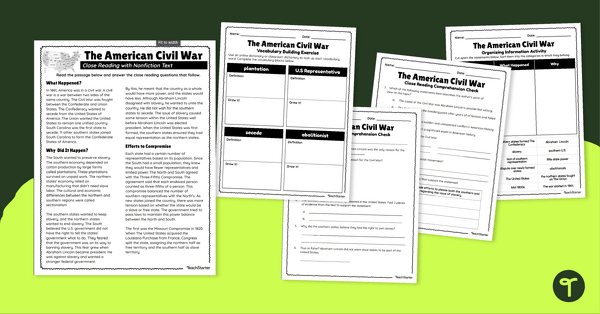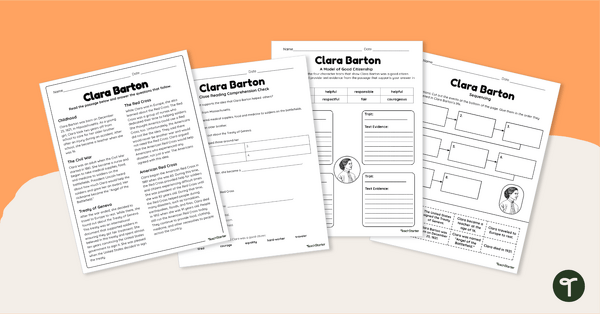Civil War Teaching Resources
Explore the Civil War in your elementary social studies classroom with printable worksheets, graphic organizers, social studies activities and everything else you need to teach about life during the Civil War era.
In this teacher-created collection, you’ll find comprehension activities, biographies of important figures and more curriculum-aligned resources carefully reviewed and chosen by our teacher team to save you time on your lesson plans.
Is this your first year teaching about the Civil War, or are you just looking for some fresh ideas? Read on for some tips from our teacher team, including important dates and figures from this period in US history.
What Is a Civil War? A Kid-Friendly Definition
Before we dive into the American Civil War, do you have a definition of civil war that you use with your class? Here's one our teacher team likes to use!
A civil war is a war that happens between different groups of people who live in the same country.
This occurs when some people in a country don't agree with the government or each other and decide to fight against each other to try to take control. In a civil war, people who used to be friends or neighbors might end up fighting against each other. It can tear families and communities apart, and it can take a long time for the country to heal and become united again.
What Was the American Civil War?
All of what we just described happened here in the United States during what we now call the American Civil War, a war that was fought between the Northern states (the Union) and the Southern states (the Confederacy).
The main reason for the war was a disagreement about slavery. The southern states wanted to keep slavery, while the northern states wanted to abolish it.
After a long, bloody war in which more than 620,000 Americans died, the northern states won the war, and slavery was abolished throughout the United States.
Activities for Teaching About the Civil War
Looking for some activities to get your students acquainted with the events leading up to the Civil War, how the war affected people in the North and South and the reconstruction era?
This teaching collection is stocked with plenty of printable and digital options, and here are a few ideas to inspire your class!
- Set Up a Civil War Museum — Assign "museum piece" projects to individual students or small groups! Set your desks up around the room, and put your students' Civil War museum artifacts on display for students from other classes to visit and learn about this part of American history.
- Create a Newspaper — Assess your students' understanding of the events that led up to the Civil War. Students can work in groups to create a newspaper that covers the major events leading up to the Civil War. They can include articles, editorials and illustrations that cover the political, social and economic factors that contributed to the outbreak of the war.
Read on for more important details of the Civil War that students will need to know before they leave elementary and middle school.
When Was the Civil War? Important Dates in History
The American Civil War was fought from 1861 to 1865. Let's take a look at some of the key dates that your students will learn about from that four-year span in history:
- April 12, 1861 — The Civil War began when Confederate forces attacked Fort Sumter, South Carolina. This attack was the inspiration for the Star Spangled Banner.
- July 21, 1861 — The First Battle of Bull Run took place in Virginia, resulting in a Confederate victory.The battle was the first major land engagement of the war.
- January 1, 1863 — President Abraham Lincoln issued his famous Emancipation Proclamation, declaring all slaves in the Confederate states to be "forever free." Although the proclamation was a significant step toward abolishing slavery, it did not immediately free any slaves.
- July 1-3, 1863 — The Battle of Gettysburg took place in Pennsylvania, resulting in a Union victory and a turning point in the war. The battle was known as the bloodiest of the war, with an estimated 51,000 casualties.
- November 19, 1863 — President Lincoln delivered the Gettysburg Address, a famous speech that highlights the importance of the Union cause.The speech was given at the dedication of the Soldiers' National Cemetery in Gettysburg, Pennsylvania, and it's one of the most famous speeches in American history.
- April 9, 1865 — Confederate General Robert E. Lee surrendered to Union General Ulysses S. Grant at Appomattox Court House in Virginia, effectively ending the Civil War.
- April 14, 1865 — President Lincoln was assassinated by John Wilkes Booth at Ford's Theatre in Washington, D.C., just days after the end of the war. He was the first American president to be assassinated.
- May 10, 1865 — Confederate President Jefferson Davis was captured by Union troops in Georgia, marking the end of the Confederate government. Davis was the only president of the Confederacy, and his capture signaled the final collapse of the Confederate states.
- June 19, 1865 — Two years after Lincoln's Emancipation Proclamation,Union General Gordon Granger arrived in Galveston, Texas, and announced that all enslaved people in Texas were to be freed. This day is now honored with the American federal holiday, Juneteenth.
- December 6, 1865 — Slavery is officially abolished in America with the ratification of the 13th Amendment to the United States Constitution. The amendment states that "Neither slavery nor involuntary servitude, except as a punishment for crime whereof the party shall have been duly convicted, shall exist within the United States, or any place subject to their jurisdiction."
Who Were the Key Figures of the Civil War?
Need a quick look at the key figures of the period that you'll want your students to know about? We've got you covered!
Abraham Lincoln
One of the most famous US presidents, Abraham Lincoln was the commander in chief during the Civil War, and his Emancipation Proclamation and Gettysburg Address are central to the war timeline.
Jefferson Davis
Jefferson Davis was the president of the Confederate States of America — the nation formed by the Southern states after secession — during the Civil War. .
Ulysses S. Grant
Ulysses S. Grant was a Union general during the Civil War who played a key role in several important battles, including the Battle of Vicksburg and the Battle of Appomattox Courthouse. Grant would later go on to become a US president.
Robert E. Lee
Robert E. Lee was a Confederate general during the Civil War who led the Confederate Army of Northern Virginia.
Harriet Tubman
Harriet Tubman was an enslaved woman and abolitionist. Her work on the Underground Railroad, a network of secret routes and safe houses used by slaves to escape to freedom, saved countless lives.
- Plus Plan

Abraham Lincoln - 3rd Grade Reading Comprehension Pack
Celebrate Presidents' Day and discover the accomplishments of Abraham Lincoln with a printable reading comprehension activity pack for 3rd grade and up.
- Free Plan

Civil War Cause and Effect Worksheet
Identify the causes of the Civil war and their effects on American society with a Civil War Cause and Effect worksheet.
- Plus Plan

Historical Heroes - Harriet Tubman Worksheets
Learn about the life and contributions of Harriet Tubman with a comprehensive pack of Women’s History Month worksheets.
- Plus Plan

Harriet Tubman Mini Book
Uncover facts about Harriet Tubman with a printable book for early readers.
- Plus Plan

Abraham Lincoln Activity Pack
Learn about the life and contributions of Abraham Lincoln with a comprehensive pack of Presidents’ Day Worksheets.
- Plus Plan

Who was Abraham Lincoln? Book
Learn about the life and contributions of Abraham Lincoln with a printable mini-book filled with facts and activities for early readers.
- Plus Plan

Abraham Lincoln Brochure Project
Demonstrate learning about the Abraham Lincoln’s contributions to America with a brochure project.
- Plus Plan

Civil War Comprehension Pack
Read across the curriculum with a printable set of Civil War Reading Passages and accompanying question sets.
- Plus Plan

Causes of The Civil War Timeline Worksheet
Build a chronological timeline for students to visually model the progression of events leading to the American Civil War.
- Plus Plan

Civil War Word Wall
Build academic vocabulary skills with an illustrated Civil War vocabulary word wall.
- Plus Plan

Causes and Effects of the Civil War - Slide Deck
Uncover the causes of the American Civil War with an instructional slide deck.
- Plus Plan

Civil War Mini Book
Read and learn about the Causes of the American Civil War with a printable Civil War book for kids.
- Free Plan

Civil War Graphic Organizer
Provide your learners with an organized note-taking method with a Civil War note-taking template.
- Plus Plan

Clara Barton Passage and Comprehension Worksheets
Uncover facts about Clara Barton with a reading passage and worksheet pack to practice comprehension, character analysis, and sequencing.
- Plus Plan

Harriet Tubman Comprehension Worksheet
Uncover facts about Harriet Tubman with a Reading Passage and Comprehension worksheet.
- Plus Plan

Who Is Harriet Tubman? – Shared Reading and Activity
Learn about Harriet Tubman and her work in the abolitionist movement with this 15-slide read-along PowerPoint presentation.